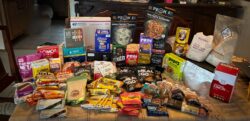If you knew there was one thing, if done correctly, that would be a major factor in your success or failure on a thru hike, would you do it ? Your food needs to be more than just calories, it must contain good and proper nutrition to fuel your body to withstand what you are going to ask it to do. Nutrition is science, follow the science.
Disclaimer:
I am educated and trained as a Chef, have degrees and diplomas in Culinary Arts and Professional Baking and Pastry, and am finishing a diploma in Holistic Nutrition at The Escoffier School of Culinary Arts. As part of my externship I will be hiking 6 weeks of my total time primarily vegan to document physical and mental changes, body measurements, adjustments to diet, and a host of other metrics. This will be done under the supervision of a Nutritionist.
I have spent the last 3 ½ years studying this stuff. The way I purchase and consume is nutritionally sound, and having free will we all make our own choices. As for products mentioned, I have not received any type of compensation for my personal recommendations and choices. I wouldn’t refuse free stuff. Just saying…
Have you wondered how many illnesses or other issues that cause a thru hiker to quit are caused by poor diet? Food for thought, no pun intended. From my schooling in Holistic Nutrition and Wellness I have found a great tool for me to analyze and adjust my diet is a website, My Fitness Pal https://www.myfitnesspal.com. You can sign up for a free account and the tools are there to help you with your overall health goals. There is a section to input the foods you consume, and their database provides choices, amounts, types, and brands for your input. A report can be generated showing calories, percentages, and deficiencies. Coupled with intermittent fasting, and strength building workouts, I have used this tool to lose 20lbs of fat and gain 25bs of muscle in preparation for my thru hike. A USDA website, My Plate https://www.myplate.gov, provides guidelines for healthy eating choices.
I would suggest that you prepare a shopping list for your resupply runs. That’s right! You should have a list in hand before your resupply run so your needs are met before your wants. Feed your body correctly and it will carry you down the trail more effectively!
My Food Bag
I pack my food bag based on daily calorie intake and total nutrition, not by meals and snacks. A 72-hour bag will contain ~12,000 calories containing a balance of protein, carbohydrates, sugars, fats, micro and macro nutrients, and any supplementation required. Knowing that while hiking I may not feel like breaking out the Jetboil for something hot, my purchases are mostly prepared foods, and stove use meals as secondary. Though I am an omnivore my diet is very plant-forward and heavy in grains, seeds, nuts, fruits, and vegetables. The goal is approximately 130 calories per ounce. Rarely do I sit down to a multi-course meal in my everyday life, so eating small portions frequently is part of my norm.
My Product List
I carry Honey Stinger products, Greenbelly Meals, Range Meal Bars, Sans Meal Bars, ProBar Meals, BoBo’s snacks, Nature’s Bakery Bars, squeeze packages of peanut butter, LMNT and Liquid IV electrolyte packets, and a variety of granolas, bars, and fruit and nut mixes. These products provide me over 4,000 calories before I prepare a meal. I’m planning on one purchased backpacker meal for every three days. Again, personal choice. Quality food is expensive compared to “junk” food. To lessen the financial strain I began my purchases 3 months ahead being mindful of shelf-life. Also, I find online discounts of up to 30% on the more expensive items by searching for discount offers. I wasn’t born with a Titanium Spoon in my mouth, budget, budget, budget. Items from my own recipes for pre-prepared hot meal recipes can be purchased at most grocery stores along the way.

The Sludge and Other Goodness
Normally I start the day with “The Sludge 1600” if I eat a hot breakfast. My creation of quick oats, chia seeds, pumpkin seeds, raisins, dehydrated banana chips, Ka’Chava Protein Powder, and peanut butter powder. The Sludge is 1600 calories and I divide it into two servings one for early morning, and place one in a small plastic container for Elevensies so that I don’t blast my kidneys with 62 grams of protein at once. Another creation consists of Jasmine rice or buckwheat Soba noodles, plant-based meat Korean BBQ, and a shelf-stable Kimchi. This type of meal is light enough to let you sleep and has probiotics to help you digest. A variety of ramen-bomb and stuffing and potato meals, tamale pies, champurrado and others in my repertoire, will be pre-packaged at home to send or assembled after a resupply run. I’ll make sure that I intake green juice, yogurt and other probiotic foods, fresh fruits and vegetables, and anything else my body requires while I am in town. This is the way I eat daily at home except using smaller portions of each to regulate calories.

Final Thoughts
Eat healthy and be healthy! The occasional guilty pleasure is a positive. There exists no “Sharing Size” bag of Peanut M&Ms… Mine, All Mine!
See you on the far side! 
This website contains affiliate links, which means The Trek may receive a percentage of any product or service you purchase using the links in the articles or advertisements. The buyer pays the same price as they would otherwise, and your purchase helps to support The Trek’s ongoing goal to serve you quality backpacking advice and information. Thanks for your support!
To learn more, please visit the About This Site page.
